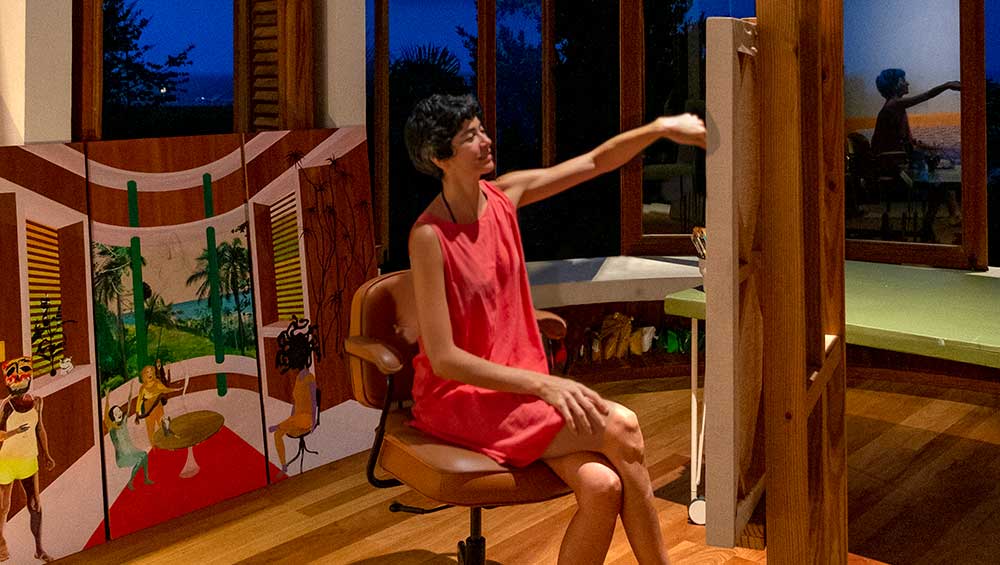
Hulda Guzmán. Portrait of artist in studio, 2021 (detail).
by EMILY SPICER
The vibrant paintings of the Dominican artist Hulda Guzmán (b1984) defy easy categorisation. They are born from a multitude of influences spanning art history and popular culture, but the key ingredient is surely Guzmán’s imagination, which fill her canvases with dancing cats, mischievous demons and a colourful cast of characters that would raise the roof at any party.
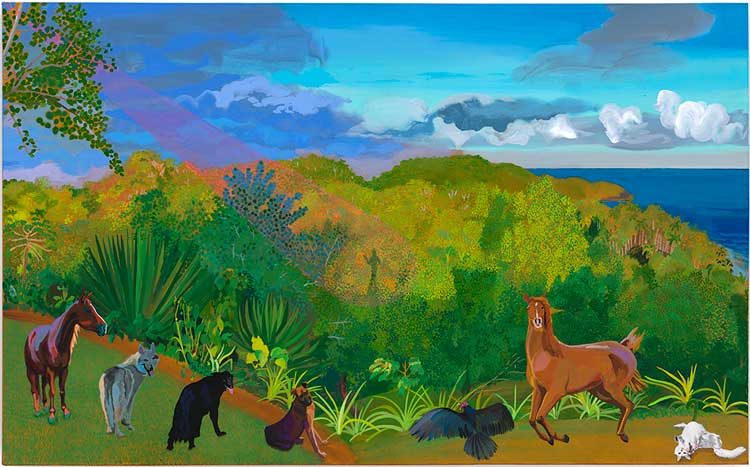
Hulda Guzmán. Everybody loves the sunshine, 2022. Acrylic gouache on linen, 78.1 x 126.4cm (30 3/4 x 49 3/4in). Copyright Hulda Guzmán. Courtesy the artist and Stephen Friedman Gallery, London. Photo: Todd-White Art Photography.
Her exhibition Meet Me at the Forest, at the Stephen Friedman Gallery in London, mixes the human with the natural world, the interior with the exterior and the magical with the quotidian. One image sees Guzmán painting in a polka-dot outfit as a cat dressed in a tutu plays a flute. Another depicts the appearance of a joyous, genie-like apparition who has appeared from the centre of a table to mixed reactions from humans and animals alike. Humour, Guzmán says, is a major component of her work and it permeates every canvas.
Emily Spicer: What was the inspiration for the show at the Stephen Friedman Gallery?
Hulda Guzmán: I did these paintings just before the show. They were the first paintings I got to paint in my new studio bungalow at the beach that has been in construction for the past couple of years and was delayed because of the pandemic. I’ve been painting a lot of nature and landscapes and plants and trees from direct observation, so it has been really good to finally be in a natural setting. Our house is in the middle of nowhere where there are lots of forests, so I was able to paint directly from nature.
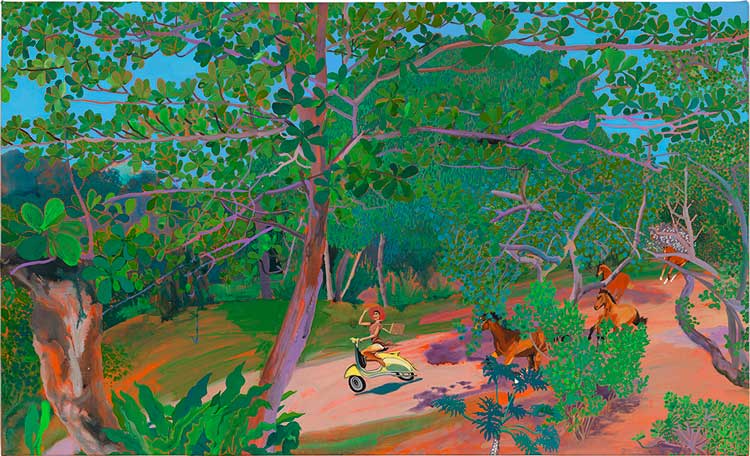
Hulda Guzmán. Jusqu'ici tout va bien, 2022. Acrylic gouache on linen, 76.8 x 126.4cm (30 1/4 x 49 3/4in). Copyright Hulda Guzmán. Courtesy the artist and Stephen Friedman Gallery, London. Photo: Todd-White Art Photography.
ES: What inspires your work more generally?
HG: I’m inspired by any art form that moves me, such as music, architecture, dance, sculpture, painting, poetry and cinema. I think that in all the realms of expression, there are the same elements of design, rhythm, composition and movement. All these elements can be translated into other forms, just like languages. I take inspiration from practically anything. And I take references from historical art movements. I love the naive depictions in medieval art, for example, the minimalism in ancient Chinese painting and the Japanese Ukiyo-e. I also love post impressionism and in sculpture, specifically modernism, I take inspiration from Isamu Noguchi and Louise Bourgeois.
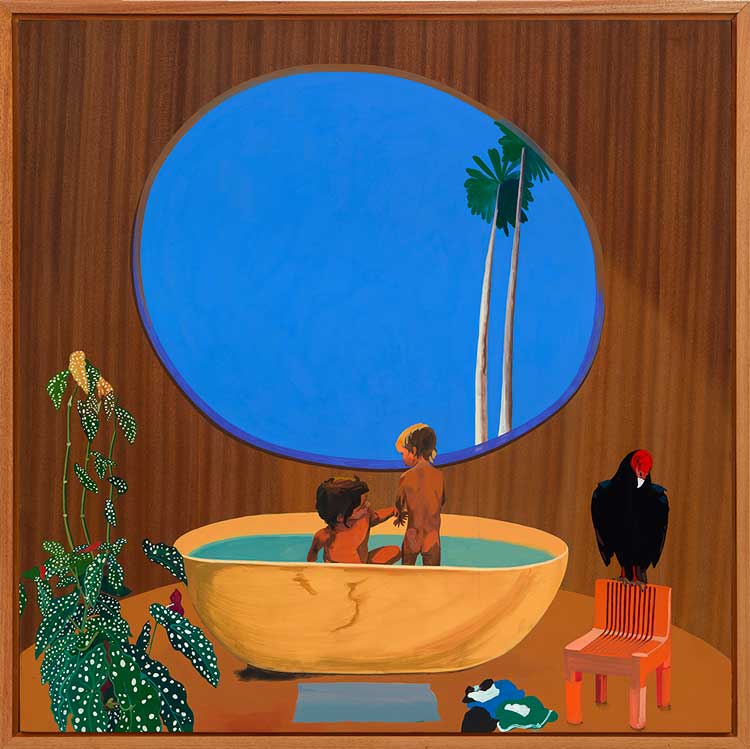
Hulda Guzmán. verdecito, 2022. Watercolour ink and acrylic gouache on cedar plywood, 96.5 x 96.5cm (38 x 38in). Copyright Hulda Guzmán. Courtesy the artist and Stephen Friedman Gallery, London. Photo: Todd-White Art Photography.
ES: You bring all these elements together to form a sort of painted collage. They remind me a little of David Hockney’s work in the 1960s and 70s.
HG: Yes, I love David Hockney. But, actually, I think, there’s this collage look because I use Photoshop. I usually start my paintings with the scenario, with the background, whether it’s a landscape or an interior scene. Then I take a picture of the painting at that stage in the process, and I put it into the computer and start to crop out all my characters. I find references everywhere and I start playing around, setting them up the way I like them. Then I transpose that into the painting.
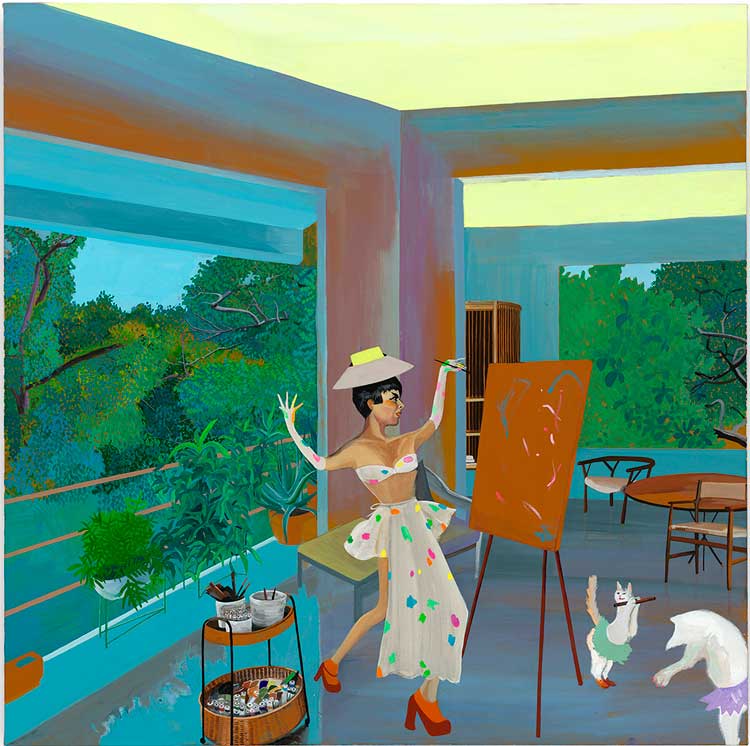
Hulda Guzmán. What's my Drag?, 2022. Acrylic gouache on linen, 114.3 x 114.3 cm (45 x 45in). Copyright Hulda Guzmán. Courtesy the artist and Stephen Friedman Gallery, London. Photo: Todd-White Art Photography.
ES: There are a lot of animals and mischievous demons in your work, but where do the human figures come from? Who are they?
HG: Mostly family and friends. I love painting my family and friends, but I also take pictures from the internet and from Instagram. Whenever I’m scrolling through Instagram and something catches my eye, maybe something specific because I’m working on a theme, I’ll take a screenshot. There are millions of pictures I have collected on my computer.
ES: Tell me about the modernist interiors you use in your paintings.
HG: My dad is an architect. We’ve been working together a lot lately because we’re developing a part of our beachside property. I learned a lot from him and his style, which is a mixture of modernist, art deco and more vernacular forms that can be adapted to the kind of weather in the tropics.
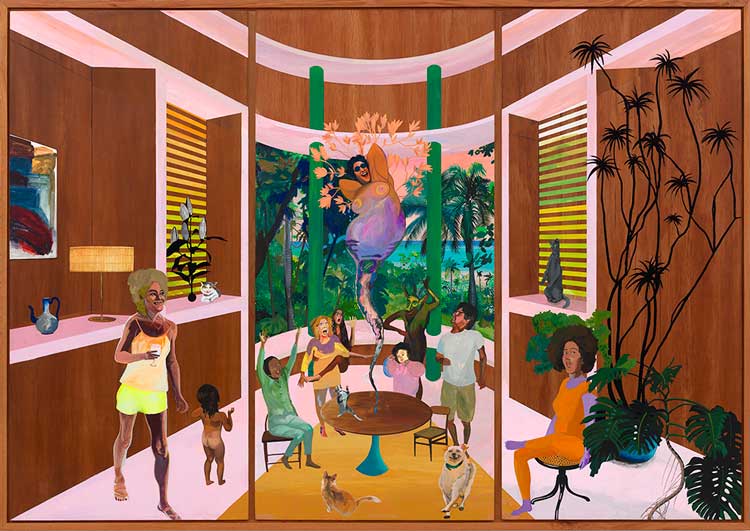
Hulda Guzmán. What you see is what it is, 2022. Watercolour ink and acrylic gouache on cedar plywood, 122 x 171cm (48 x 67 1/4in). Triptych: 121.9 x 57.15cm (48 x 22 1/2in) each. Copyright Hulda Guzmán. Courtesy the artist and Stephen Friedman Gallery, London. Photo: Todd-White Art Photography.
ES: I would like to ask you about a specific painting because it is so strange and wonderful. Can you tell me about What You See Is What It Is?
HG: Yes, so this was the only thing that I didn’t start a few months before the show. I started it over a year before, when my studio bungalow was under construction. I was anxious to start living there and know how it would feel to be in it, so I made a rendering of the interior in a very naive sense, not following the correct proportions. It’s something my dad cannot deal with because, being an architect, he’s all about proportions and how everything has to be in relation to the human body. When he sees that I paint architecture in a naive way, he starts twitching! He can’t even look at it.
I did my depiction of the studio and then started working on the characters. The main character is my best friend, Natalia, who is manifesting from nothing, out of the blue, and causing different reactions in all the other characters. I think it speaks to how our reactions determine our experiences. Some of the characters are scared, others are amused. I just wanted to depict how emotions are a basis for manifestation in life.
ES: So, it’s about objectivity, how we react to the world. If we are scared, something is scary. If we are amused, something is harmless and funny.
HG: Exactly. The world is a reflection of our inner selves.
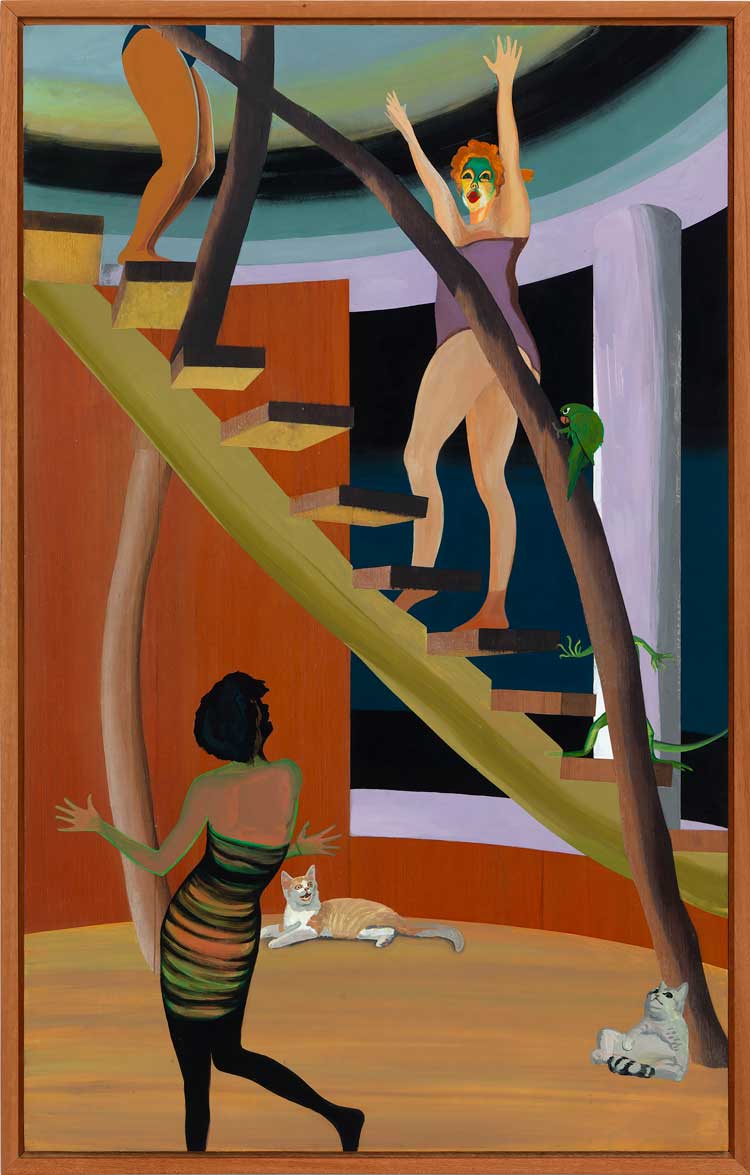
Hulda Guzmán. Up the spine, 2022. Acrylic gouache and watercolour ink on cedar plywood, 121.9 x 76.2cm (48 x 30in). Copyright Hulda Guzmán. Courtesy the artist and Stephen Friedman Gallery, London. Photo: Todd-White Art Photography.
ES: Can you tell me about the humour in your work as well. It’s really unusual, I think, to find such joyousness in modern painting.
HG: I think viewers always perceive the energy – the certain vibrations – that comes with the artworks. I don’t like to paint if I’m not feeling very well. I don’t want to share any negativity. I really try to get in a very positive mindset, to raise my vibrations to high frequencies of love and gratitude when I’m painting and it’s wonderful for me to see how that comes across. With the humour, it’s also about sharing positivity and the lightness of being. I believe that life shouldn’t be taken too seriously. When we’re able to laugh at ourselves and just be part of the joke, everything is just so much better. I think that’s one of the wonderful things we as humans can bring to life. Nature is so complete and so wonderful, but is there humour in nature, I wonder? So many times, my cats will make me laugh. I’m cracking up and my cats are looking so serious! If they could only laugh, it would be so much better. It is such a wonderful thing to be able to laugh, such a wonderful feeling. It’s probably a stupid thing to say, but it makes me feel a little bit bad for the rest of the natural world, that it can’t laugh.
ES: I have never thought about it like that. I’m trying to think of animals that maybe do laugh.
HG: My friend says his dog laughs. He smiles, and yes, of course, animals can smile and be happy and cheerful and playful, but can they laugh? Even babies laugh; they really crack up. I like to share that in my paintings, and I work on it a lot. I practise my comedy; I study it. I watch a lot of stand-up comedians. I think everyone should work on their humour.
ES: Is there anything you would like to say about your work? Something you never get asked?
HG: I think I’d just like to convey a sense of symbiosis and unity with nature, a sense of not feeling the separateness that comes from the analytical self, but rather feeling a part of nature, when it lets you be in a state of presence. And from there it’s just such a wonderful feeling to allow nature to nourish us and anchor ourselves within the environment. But I think that people do get that [from my paintings]. When I get messages from people, they always tell me that my works brought them so much joy. For me, that’s the best compliment because that’s the intention, to stop the judgment and just being in a loving presence.
• Hulda Guzmán: Meet Me in the Forest is at the Stephen Friedman Gallery, London, until 14 April 2022.